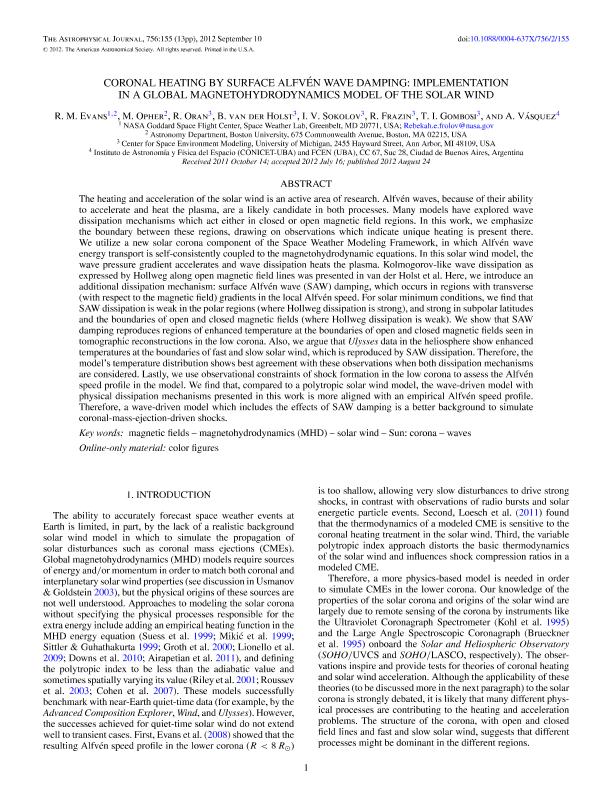Artículo
Coronal heating by surface Alfvén wave damping: Implementation in a global magnetohydrodynamics model of the solar wind
Evans, Rebekah M.; Opher, M.; Oran, R.; van der Holst, Bartholomeus; Sokolov, I.V.; Frazin, Richard A.; Gombosi, Tamas I.; Vasquez, Alberto Marcos

Fecha de publicación:
09/2012
Editorial:
IOP Publishing
Revista:
Astrophysical Journal
ISSN:
0004-637X
Idioma:
Inglés
Tipo de recurso:
Artículo publicado
Clasificación temática:
Resumen
The heating and acceleration of the solar wind is an active area of research. Alfvén waves, because of their ability to accelerate and heat the plasma, are a likely candidate in both processes. Many models have explored wave dissipation mechanisms which act either in closed or open magnetic field regions. In this work, we emphasize the boundary between these regions, drawing on observations which indicate unique heating is present there. We utilize a new solar corona component of the Space Weather Modeling Framework, in which Alfvén wave energy transport is self-consistently coupled to the magnetohydrodynamic equations. In this solar wind model, the wave pressure gradient accelerates and wave dissipation heats the plasma. Kolmogorov-like wave dissipation as expressed by Hollweg along open magnetic field lines was presented in van der Holst et al. Here, we introduce an additional dissipation mechanism: surface Alfvén wave (SAW) damping, which occurs in regions with transverse (with respect to the magnetic field) gradients in the local Alfvén speed. For solar minimum conditions, we find that SAW dissipation is weak in the polar regions (where Hollweg dissipation is strong), and strong in subpolar latitudes and the boundaries of open and closed magnetic fields (where Hollweg dissipation is weak). We show that SAW damping reproduces regions of enhanced temperature at the boundaries of open and closed magnetic fields seen in tomographic reconstructions in the low corona. Also, we argue that Ulysses data in the heliosphere show enhanced temperatures at the boundaries of fast and slow solar wind, which is reproduced by SAW dissipation. Therefore, the model's temperature distribution shows best agreement with these observations when both dissipation mechanisms are considered. Lastly, we use observational constraints of shock formation in the low corona to assess the Alfvén speed profile in the model. We find that, compared to a polytropic solar wind model, the wave-driven model with physical dissipation mechanisms presented in this work is more aligned with an empirical Alfvén speed profile. Therefore, a wave-driven model which includes the effects of SAW damping is a better background to simulate coronal-mass-ejection-driven shocks. © 2012. The American Astronomical Society. All rights reserved.
Palabras clave:
Magnetic Fields
,
Magnetohydrodynamics (Mhd)
,
Solar Wind
,
Sun: Corona
,
Waves
Archivos asociados
Licencia
Identificadores
Colecciones
Articulos(IAFE)
Articulos de INST.DE ASTRONOMIA Y FISICA DEL ESPACIO(I)
Articulos de INST.DE ASTRONOMIA Y FISICA DEL ESPACIO(I)
Citación
Evans, Rebekah M.; Opher, M.; Oran, R.; van der Holst, Bartholomeus; Sokolov, I.V.; et al.; Coronal heating by surface Alfvén wave damping: Implementation in a global magnetohydrodynamics model of the solar wind; IOP Publishing; Astrophysical Journal; 756; 2; 9-2012; 155-168
Compartir
Altmétricas



